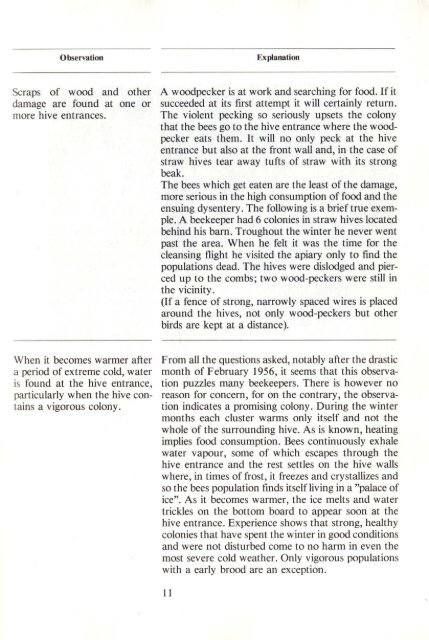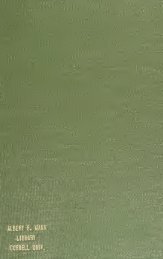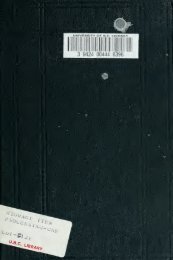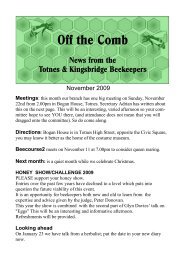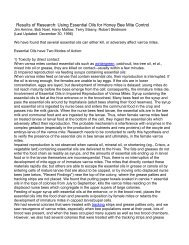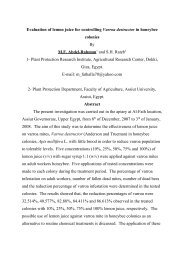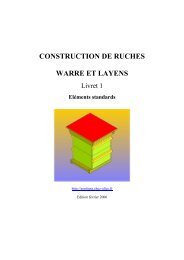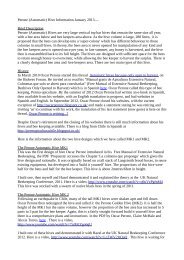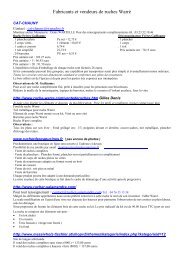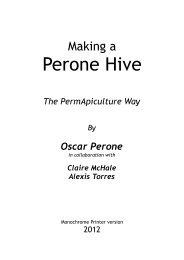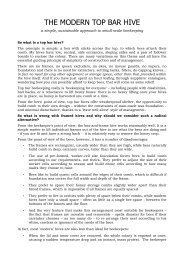Create successful ePaper yourself
Turn your PDF publications into a flip-book with our unique Google optimized e-Paper software.
Observation<br />
Explanation<br />
Scraps of wood and o<strong>the</strong>r<br />
damage are found at one or<br />
more hive entrances.<br />
A woodpecker is at work and searching for food. If it<br />
succeeded at its first attempt it will certainly return.<br />
The violent pecking so seriously upsets <strong>the</strong> colony<br />
that <strong>the</strong> bees go to <strong>the</strong> hive entrance where <strong>the</strong> woodpecker<br />
eats <strong>the</strong>m. It will no only peck at <strong>the</strong> hive<br />
entrance but also at <strong>the</strong> front wall and, in <strong>the</strong> case of<br />
straw hives tear away tufts of straw with its strong<br />
beak.<br />
The bees which get eaten are <strong>the</strong> least of <strong>the</strong> damage,<br />
more serious in <strong>the</strong> high consumption of food and <strong>the</strong><br />
ensuing dysentery. The following is a brief true exempIe.<br />
A beekeeper had 6 colonies in straw hives located<br />
behind his barn. Troughout <strong>the</strong> winter he never went<br />
past <strong>the</strong> area. When he felt it was <strong>the</strong> time for <strong>the</strong><br />
cleansing flight he visited <strong>the</strong> apiary only to find <strong>the</strong><br />
populations dead. The hives were dislodged and pierced<br />
up to <strong>the</strong> combs; two wood-peckers were still in<br />
<strong>the</strong> vicinity.<br />
(If a fence of strong, narrowly spaced wires is placed<br />
around <strong>the</strong> hives, not only wood-peckers but o<strong>the</strong>r<br />
birds are kept at a distance).<br />
When it becomes warmer after<br />
a period of extreme cold, water<br />
is found at <strong>the</strong> hive entrance,<br />
particularly when <strong>the</strong> hive contains<br />
a vigorous colony.<br />
From all <strong>the</strong> questions asked, notably after <strong>the</strong> drastic<br />
month of February 1956, it seems that this observation<br />
puzzles many beekeepers. There is however no<br />
reason for concern, for on <strong>the</strong> contrary, <strong>the</strong> observation<br />
indicates a promising colony. During <strong>the</strong> winter<br />
months each cluster warms only itself and not <strong>the</strong><br />
whole of <strong>the</strong> surrounding hive. As is known, heating<br />
implies food consumption. Bees continuously exhale<br />
water vapour, some of which escapes through <strong>the</strong><br />
hive entrance and <strong>the</strong> rest settles on <strong>the</strong> hive walls<br />
where, in times of frost, it freezes and crystallizes and<br />
so <strong>the</strong> bees population finds itself living in a "palace of<br />
ice". As it becomes warmer, <strong>the</strong> ice melts and water<br />
trickles on <strong>the</strong> bottom board to appear soon at <strong>the</strong><br />
hive entrance. Experience shows that strong, healthy<br />
colonies that have spent <strong>the</strong> winter in good conditions<br />
and were not disturbed come to no harm in even <strong>the</strong><br />
most severe cold wea<strong>the</strong>r. Only vigorous populations<br />
with a early brood are an exception.<br />
11


